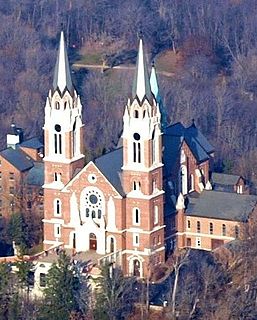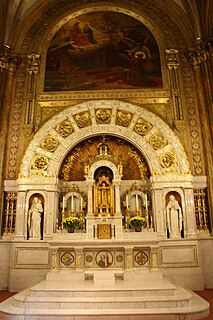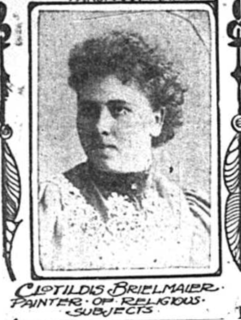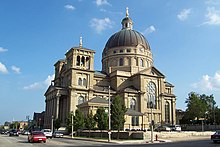
The Archdiocese of Milwaukee is a Latin Church ecclesiastical territory or archdiocese of the Catholic Church headquartered in Milwaukee, Wisconsin in the United States. It encompasses the City of Milwaukee, as well as the counties of Dodge, Fond du Lac, Kenosha, Milwaukee, Ozaukee, Racine, Sheboygan, Walworth, Washington and Waukesha, all located in Wisconsin.

The Basilica of Saint Hyacinth is a historic church of the Roman Catholic Archdiocese of Chicago, located at 3636 West Wolfram Street in the Avondale neighborhood of Chicago, Illinois.

The Cathedral Basilica of Saints Peter and Paul, head church of the Roman Catholic Archdiocese of Philadelphia, is located at 18th Street and the Benjamin Franklin Parkway, on the east side of Logan Square in Philadelphia. It was built between 1846 and 1864, and was designed by Napoleon LeBrun, from original plans by the Reverend Mariano Muller and the Reverend John B. Tornatore, with the dome and Palladian facade, designed by John Notman, added after 1850. The interior was largely decorated by Constantino Brumidi.

Calvary Cemetery is the oldest existing Catholic cemetery in Milwaukee, Wisconsin. Owned by the Archdiocese of Milwaukee, it is the final resting place for many of the city's early influential figures. The cemetery was designated a Milwaukee Landmark in 1981.

Holy Hill Basilica and National Shrine of Mary, Help of Christians is a Roman Catholic shrine in the north central United States, dedicated to the Blessed Virgin Mary. The centerpiece of the shrine is a minor basilica. It is located in the town of Erin, near Hubertus, Wisconsin, in the Roman Catholic Archdiocese of Milwaukee. The shrine has approximately 300,000 visitors per year.
SS. Cyril and Methodius in Lemont - historic church of the Roman Catholic Archdiocese of Chicago, located in Lemont, Illinois.

Tadeusz Żukotyński was a Polish count, professor, and painter.
SisterMaria Stanisia, S.S.N.D., was an American Catholic nun, artist, and painter, member of the School Sisters of Notre Dame.

Immaculate Heart of Mary Church in Pittsburgh, referred to in Polish as Kościół Matki Boskiej, is a historic church of the Catholic Diocese of Pittsburgh, one of the city's oldest and largest churches. Located on Polish Hill in Pittsburgh, Pennsylvania, it is a prime example of the so-called 'Polish Cathedral' style of churches in both its opulence and grand scale.

St. Stanislaus Kostka Church in Pittsburgh, Pennsylvania, referred to in Polish as Kościół Świętego Stanisława Kostki is a historic church of the Roman Catholic Diocese of Pittsburgh. Located in the Strip District in Pittsburgh, Pennsylvania, United States, it is a prime example of the so-called 'Polish Cathedral' style of churches. It is known also as 21st and Smallman Street Church. It is listed on the U.S. National Register of Historic Places.
Mary Thomasita Fessler was an American painter and religious sister. Her work consisted of paintings, sculptures, and designs for stained-glass windows.

Erhard Brielmaier was an architect in the United States and Canada from the late 19th century through the early 20th century. He designed and built more churches and hospitals than any other architect.

Saint Stanislaus Kostka Catholic Church is a historic Polish church of the Roman Catholic Archdiocese of Chicago that is located at 1351 West Evergreen Avenue in the Pulaski Park neighborhood of Chicago, Illinois, United States. It is designated as the Sanctuary of Divine Mercy of the Archdiocese.
Bernard Otto Gruenke was an American stained glass artist who produced one of the first faceted glass windows in the United States in 1949. He was born in Sheboygan, Wisconsin.
Lincoln Village is a south side neighborhood within the City of Milwaukee.
Gonippo Raggi was an Italian artist who provided murals for many churches and church institutions in the United States.

St. George Melkite Catholic Church is a Melkite Greek Catholic Church, located in Milwaukee, Wisconsin. It was added to the National Register of Historic Places in 1986. The church was built in 1917 to serve the needs of the Syrian-Lebanese community who migrated to Milwaukee after the Chicago World's Fair of 1892. It is the second oldest Melkite church in the United States.

The Basilica of Saint Stanislaus Kostka is a historic church of the Roman Catholic Diocese of Winona in Winona, Minnesota, United States, and a prominent fixture on the city's skyline. Within the diocese it is better known as Saint Stan's. It was listed on the National Register of Historic Places in 1984 as Church of St. Stanislaus–Catholic and was designated as a Minor Basilica of the Roman Catholic Church on November 10, 2011 by Pope Benedict XVI.

Clotilde Elizabeth Brielmaier, sometimes called "Lottie" Brielmaier, was a German-American religious painter, specializing in portraits and church murals. She was the daughter of the famous Milwaukee architect Erhard Brielmaier and often collaborated with her family members on projects. She spent several years, as many as twenty, studying at the art centers of Europe including Munich and Rome. She is said to be the first female artist to establish her own studio in the United States, which was located in the now demolished University Building in Milwaukee, Wisconsin.















